Table of Contents
Two major methods are available for effective recycling of metallic values in discarded automobiles. The first of these is the incineration, din- mantling, and baling or baling-shearing method. The economics of this operation were reported in 1969. The second procedure is that of shredding, in which a partially dismantled automobile less radiator, battery, tires, differential, transmission, and engine is reduced to fist-size chunks in a hammer mill or gear mill. The shredded scrap is passed over a magnetic separator whereby the steel is separated from the nonferrous metals and nonmetallics.
In 1965 approximately 7 million cars were discarded in the United States, and about 90 percent of these were processed by scrap yards. The number of cars processed during 1970 was approximately 8 million, about 3.5 million of which were processed by 80 shredders operating across the country. Most of the shredder operators discard the nonmagnetic fractions after a simple hand-sorting operation removes the larger pieces of copper, aluminum, and zinc. A typical shredder operation, for example, shows an 18-month average recovery of only 28 and 14 percent, respectively, of the white and red metals from the nonmagnetic reject. To prevent wastage of such large quantities of valuable metals in the rejects, the Bureau of Mines conducted studies on the separation of the metals from the nonmetals in the shredded nonmagnetic fraction.
Magnetic separation, screening, hand sorting, incineration, air and water elutriation, jigging, sink-float, leaching, and liquation were explored as possible techniques for making initial separations or for upgrading the initial products obtained. Air elutriation, because of simplicity and economy of operation, offers advantages over other procedures and was selected as the primary separation stage. This report describes the results of the air elutriation work to date. The information presented outlines a method enabling shredder operators to recover the metallic values present in the reject material in a high-metal product adaptable to more efficient hand-sorting operations or further separation and recovery of the metallic values. Work is continuing to develop a complete recovery system to separate and recover the individual non-ferrous metals.
Quantity Composition and Value of Auto Shredder Reject Material
A typical automobile of 1954-65 vintage contains, in pounds, 2,532 steel, 511 cast iron, 32 copper, 54 zinc, 51 aluminum, 20 lead, 145 rubber, 87 glass, 127 other combustibles, and 15 other noncombustibles. Removal of the gas tank, radiator, battery, engine, transmission, differential, and tires prior to shredding reduces the nonferrous metal and nonmetallic contents, in pounds, to approximately 5 copper, 45 zinc, 9 aluminum, 2 lead, and 45 rubber. The glass and other noncombustibles and combustibles remain essentially the same. Thus, shredding an average unincinerated car should produce nonmagnetic rejects containing about 335 pounds of nonferrous and nonmetallic materials. The reject materials from the 3.5 million cars shredded each year would amount to 586,265 tons, or about 7,800 tons of rejects per year for an average shredder. The shredder reject from a typical car, if the separation of ferrous from nonferrous and nonmetallic were complete, would consist of the following:

Note.-Throughout this report, all percentage figure are weight-percent
Actual samples typical of unpicked nonmagnetic rejects have been obtained from several shredding operations. The analyses for three selected samples and for the composite of these samples are given in table 1.

The composite analysis obtained corresponds reasonably well with the postulated analysis for an entire car if consideration is taken of the condition of the hulks when received at the shredder. Much glass is broken from the average car hulk, trim is often removed, and many shredders incinerate the cars or remove the seats prior to shredding, thus decreasing the content of combustibles and generally increasing the metallic and noncombustible percentage 1.
Based on the composite analysis and postulated prices for recoverable scrap metals as given, the values would be as follows:

Based on these figures, an average shredder in discarding approximately 7,800 tons per year of material would waste 150 tons per week of rejects valued at approximately $8,200.
Equipment Selection and Design
Various concentration methods including screening, jigging, sink-float, water elutriation, and incineration were investigated prior to selection of air elutriation for obtaining initial separations of reject materials. All processes using water as a medium were unsatisfactory because the water was absorbed in large quantities by the paper, textiles, paddings, and other fibrous materials in the reject products, and separations were not effective.
Incineration of the crude reject materials was also ineffective. Burning of the fibrous materials raised the temperature rapidly, and the low-melting-point metals, such as zinc die cast and lead, fused into clumps from which separation of the individual metals was impractical. Conversely, the low density of the fibrous materials as compared with the metallic fractions was advantageous to the air elutriation procedures.
Two alternative air elutriation devices were evaluated in preliminary laboratory work. Both a vertical-column type and a horizontal-blower type proved effective for making excellent separations. Therefore, two larger systems patterned after the laboratory models but having sufficient capacity for treating materials rejected by an average size shredder were constructed and tested. The horizontal elutriator proved more effective in laboratory testing and was constructed first. The column elutriator was built subsequently as an adjoining device to use the same blower as a motive force.
Horizontal Elutriator
A drawing of the horizontal air elutriating system is shown in figure 1. In this system, material is discharged from a variable-speed belt feeder into an enclosed sloping chute which enters the top of the elutriator. The discharge from the chute strikes a baffle which causes it to drop vertically into the horizontally moving air stream. The air stream is produced by an industrial type LS centrifugal blower with a capacity of 1,030 standard cubic feet per minute (scf/min) at 8-inch water column pressure. The fan is driven at 2,800 rpm by a 3-hp motor. (A sliding gate on the blower inlet can be set to obtain air flows from 1,200 to 3,500 scf/min with static pressures ranging from 0.05 to 0.4 inch water column vacuum, respectively.)
The blower has an 8-inch-square outlet set below the discharge chute, and the air stream blows the feed material into a 12-inch-wide by 6-foot-long compartmented chamber, open at the upper front end. The metals, plastics, hard rubber, and other materials of higher density fall into the front compartments, and the paper, textiles, fibers, and lighter materials are rejected into the compartments more distant from the blower. A baghouse was used to collect the finer materials at the opposite end from the blower. The cost of constructing the horizontal air elutriator was $685, which includes $60 for materials, $150 for labor, and $475 for the blower. The cost of the feeder is not included.
Vertical Elutriator
A schematic drawing of the vertical elutriator is shown in figure 2. This equipment can be used to obtain a preliminary separation or to process middling fractions from the horizontal elutriator system. As a preliminary or rougher separator, the feed is added from a holding bin on the top end which drops the material onto a variable-speed drum serving as a feed regulator to the column. The material passes from the drum into a feeding chute attached at a 45° angle to the elutriating column about halfway up the tube. The material entering the column is elutriated in a rising air stream produced by the same centrifugal blower as used in the horizontal system. Heavier particles drop out the bottom of the vertical column as the lighter material is carried
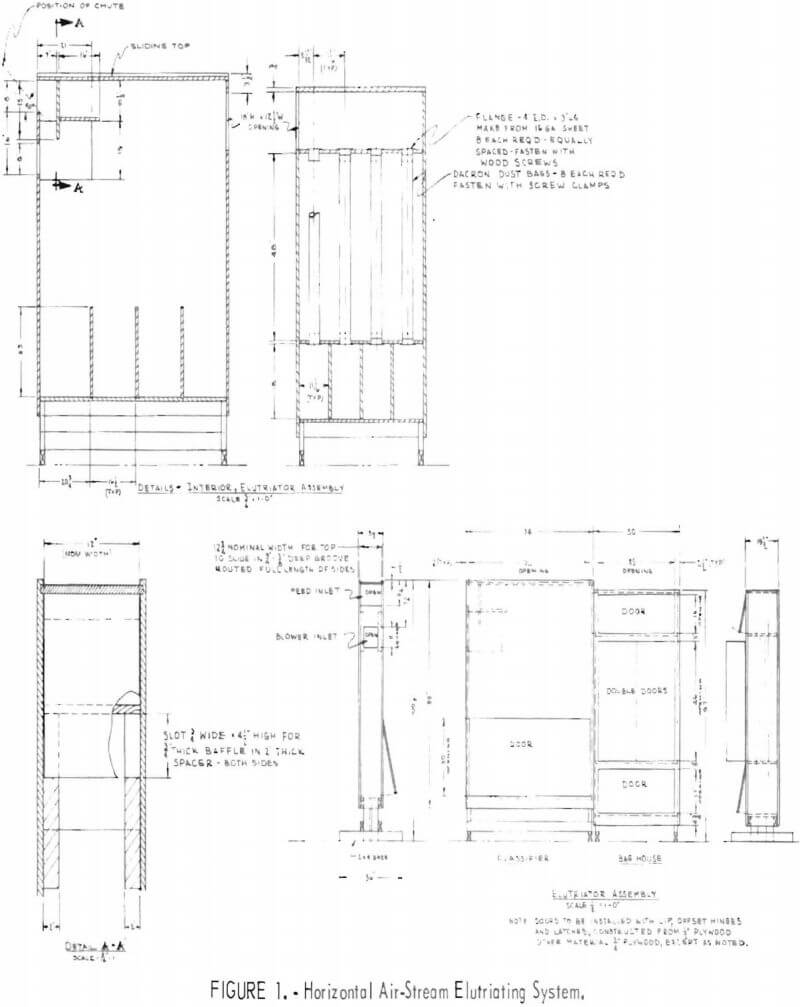
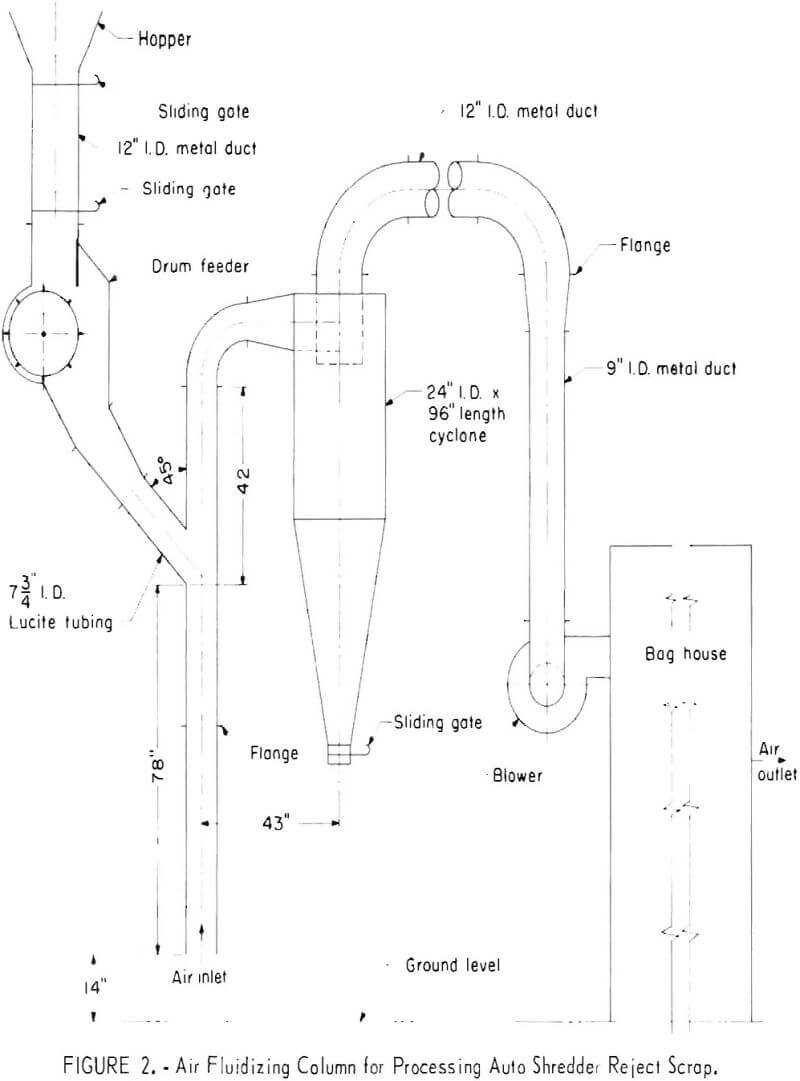
upwards and into a cyclone for collection. The material collected in the bottom of the cyclone is periodically discharged through a bottom sliding gate. The cyclone collector is efficient so that only a negligible quantity of dust is carried back through the cyclone air outlet pipe to the blower. Figure 3 shows the horizontal blower and the vertical air classifier.
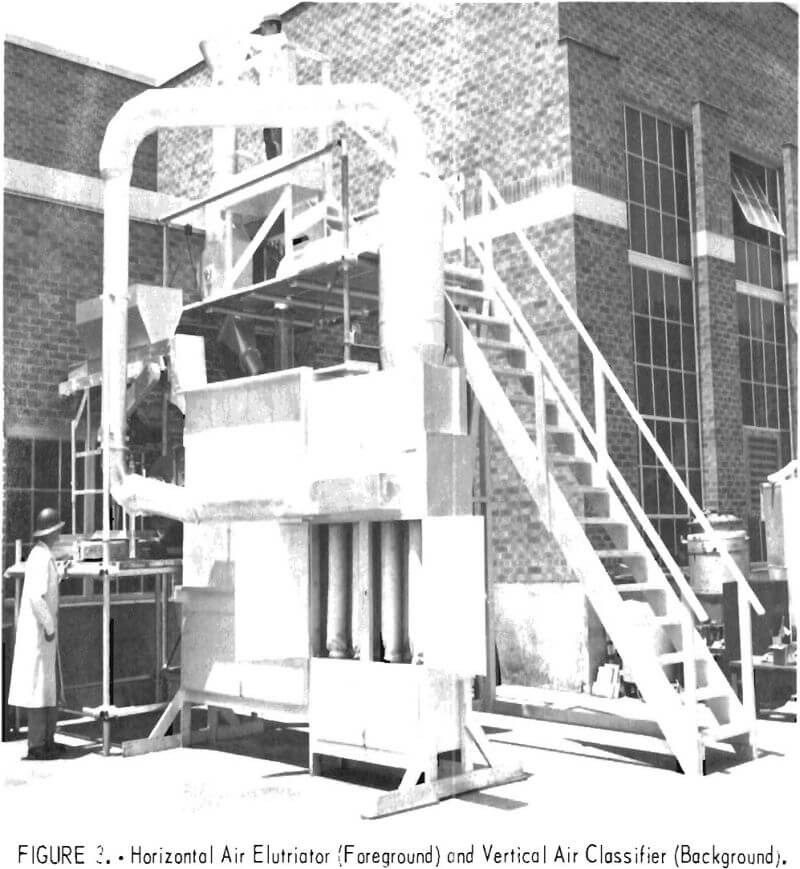
Operational Results
Horizontal Elutriator
Approximately 150 tons per week of nonmagnetic rejects are produced by the average car shredding operation. Based on this figure, the pilot plant horizontal blower was built to handle at least this quantity of shredder reject material in an operating week of 5 days or less. Material tested was a composite reject similar to sample C in table 1, containing about 40 percent metal. Preliminary tests showed that a belt feeder depth of about 3 inches gave the best results when feeding into a horizontal air stream. Employing this depth of material and varying the belt speed from 24 to 96 feet per minute permitted feeding from 4.5 to over 16 to.id per hour to the elutriator. Increasing the air rate from the blower from 1,900 to 3,500 scf/min as the feed rate was increased produced the results presented in table 2.
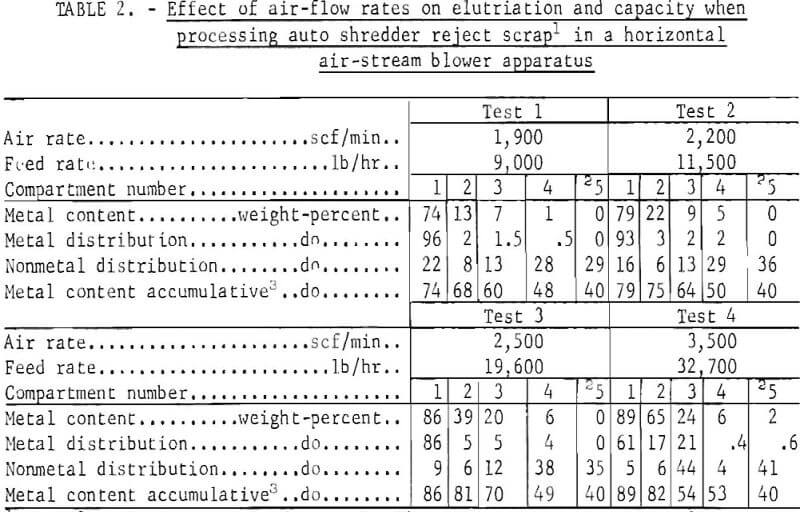
The data in table 2 show that, by compositing the products recovered in separate bins, metal recoveries of at least 96 percent with varying rejection of nonmetallic wastes are possible. Selected products from tests 1, 2, and 3 provide the following results:

The efficiency of the split obtained decreased only slightly as the tonnage increased for tests 1, 2, and 3, but showed a more marked decrease at the highest tonnage of test 4. If maximum recovery of metals consonant with maximum rejection of nonmetallics is accepted as the most desirable goal, then the lower tonnage throughput results of tests 1 and 2 are preferable.
Approximately 30 percent of the metals in the concentrated metal product was removed by magnetic separation. About 75 percent of the iron thus recovered was plus 4-mesh discrete metallic iron fragments, and 25 percent was minus 4 mesh consisting of a mixture of iron metal and mill scale. The non-ferrous metal product that is recovered after magnetic reparation of iron is mainly contaminated with pieces of rubber moulding, and glass and dirt. Hand sorting, heavy media separation, or water elutriation procedures are being tested to produce a final upgraded metal mixture that is amenable to conventional melting and/or distillation procedures for recovery of the individual metal components. Preliminary tests using galena as the heavy medium and processing the air-elutriated 74-percent-metal concentrate from test 1 at a specific gravity of 2.1 produced a 99-percent-metal product with an overall air elutriator and heavy media recovery of 91 percent.
Vertical Column
Preliminary tests in the vertical column at high throughputs indicated that separations were not as good as obtained in the horizontal blower. Therefore, tests were run at lower tonnage throughputs to evaluate the column both for initial separations and as a secondary middlings separator. Tests were made varying the feed rate and air-flow rate to determine the best combinations for obtaining optimum separations of the reject scrap. Feed rates were varied from 1.8 to 9 tons per hour, and the air rate from 900 to 1,400 scf/min. Results are presented in table 3.
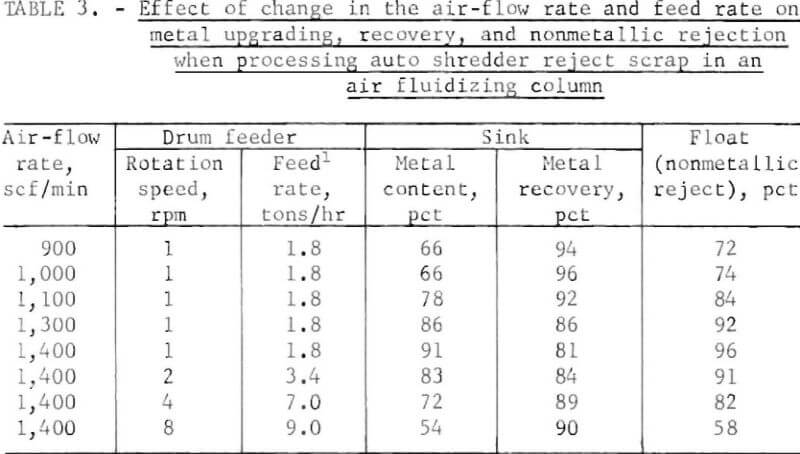
Results of these tests indicate that, at the lowest feed rate of 1.8 tons per hour and air-flow rates of 1,000 to 1,100 scf/min, the separations achieved in the vertical column were reasonably comparable to those achieved with the horizontal blower at 5.75 tons per hour and an air rate of 2,200 scf/min.
Combined Operations
As the blower for the horizontal elutriator can serve as the motive force for the vertical elutriator, consideration was given to using the two systems in concert. The tandem use of the two devices envisages using the horizontal blower as a roughing separatory elutriator and the vertical column for cleaning the rougher products. Locked tests have not been made, but the process has been simulated in separate tests. Note, too, that a horizontal blower possibly could be used for retreating the middling products, but preliminary retreatment testing was done in the vertical device because of the potentiality of continuous processing. Feed material for the simulated locked tests contained 4 percent less metal than for tests 1 through 4, but otherwise was comparable. The initial separations were made in the horizontal elutriator at two feed rates of 4.5 and 9 tons per hour. Bin products from the initial separation were reprocessed in the vertical elutriator, simulating bottom feeding such as would be practiced if the bin product were to discharge onto a conveyor belt passing under the vertical column. Results are reported in tables 4 and 5,
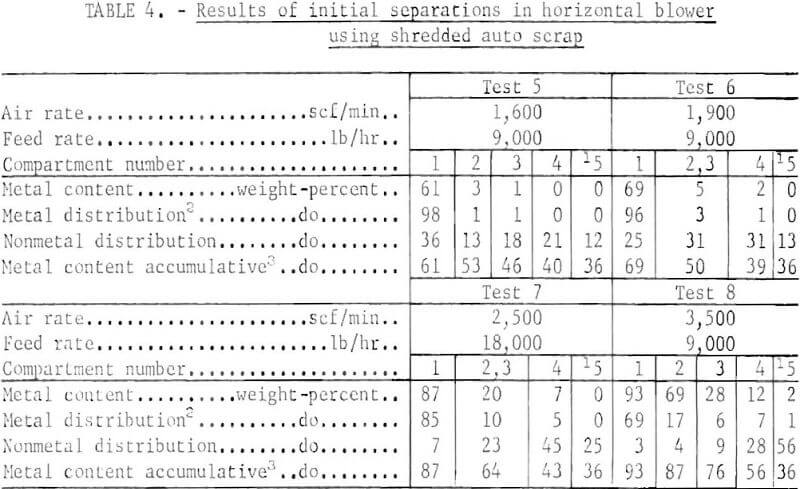
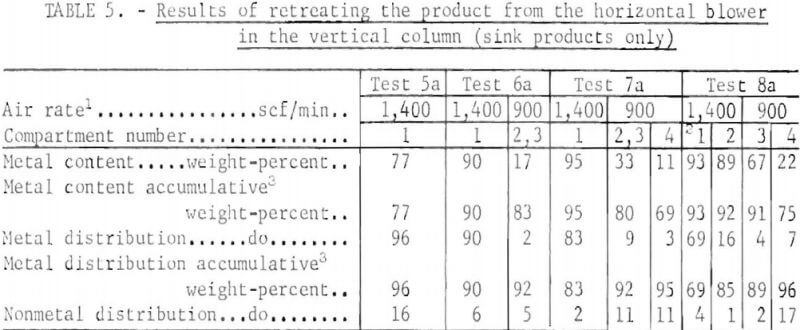
A comparison of the results in tables 2 and 4 shows that the initial separations achieved on the 36-percent-metal content feed were not as effective as for the 40-percent feed. Retreatment of the initial products, however, produced satisfactory products at the excellent overall recoveries shown in table 5. Test 5a shown that retreatment of bin 1 material produced a 77-percent-metal product containing 96 percent of the metal and only 16 percent of the nonmetallics. Comparison of these results with those of test 1 in table 1 shows that retreatment of only one product from the lower grade feed material produced a metal concentrate containing 3 percent more metal while rejecting 6 percent more of the nonmetallics at the same metal recovery. Reelutriation of bin 2, 3, and 4 products as in test 8a gave a 96-percent- metal recovery in a 75-percent-metal product while rejecting 76 percent of the nonmetallics.
